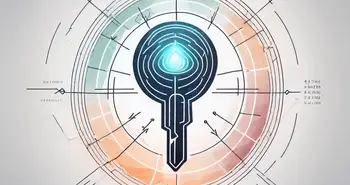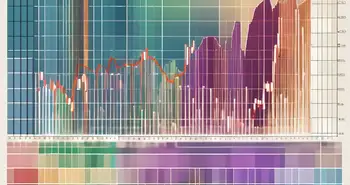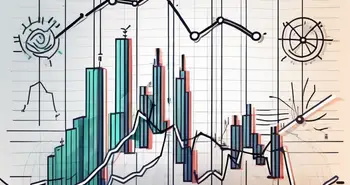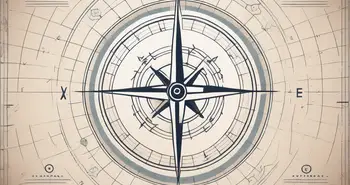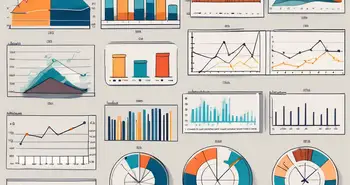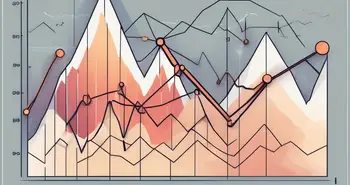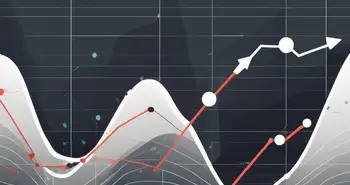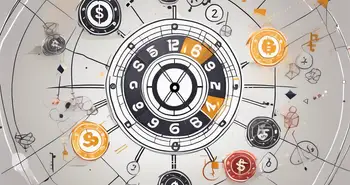Understanding the Benefits and Application of Kagi Charts

As an experienced trader, I have come to appreciate the power and versatility of Kagi charts. These unique charting tools offer valuable insights into market trends and help traders make informed investment decisions. In this comprehensive guide, I will take you through the various aspects of Kagi charts, from their origins and structure to their practical application and interpretation. By the end of this article, you will have a solid understanding of how Kagi charts can enhance your trading strategies.
Introduction to Kagi Charts
Let's begin by delving into the fascinating history of Kagi charts. Developed in Japan during the 1870s, Kagi charts were primarily used to analyze rice prices. Over time, their application expanded to other financial markets, making them an indispensable tool for traders worldwide. The basic structure of Kagi charts is simple yet powerful, providing a visual representation of price movements that can give unique insights into market trends.
Origin and Development of Kagi Charts
Long before the days of computers and sophisticated charting software, Japanese chartists relied on Kagi charts to analyze the price of rice. The word “Kagi” translates to “reversal,” reflecting the essence of these charts. Introduced by Japanese journalist Sokyu Honma, Kagi charts captured the dynamic nature of price movements, focusing on significant changes rather than the incremental fluctuations seen in other charting methods like candlestick charts.
During the 17th century, Japan experienced a rapid expansion of its rice market. As a result, traders sought a method to analyze price movements and identify potential reversals. Sokyu Honma, a journalist and rice trader, recognized the need for a charting technique that could effectively capture the essence of market dynamics. This led to the development of Kagi charts, which gained popularity among Japanese traders.
By ignoring time and focusing solely on price changes, Kagi charts provide a clear representation of trend reversals, allowing traders to make timely decisions. The simplicity of Kagi charts made them accessible to a wide range of traders, from seasoned professionals to novice investors.
Basic Structure of Kagi Charts
Understanding the basic structure of Kagi charts is essential to gain mastery over this tool. Kagi charts consist of a series of vertical lines, known as “kagi lines,” that indicate whether the trend is bullish (rising prices) or bearish (falling prices).
When a bullish trend is observed, a solid line is drawn from the bottom of the last kagi line. This line continues until the price reverses by a specified amount, known as the “reversal value.” The reversal value is determined by the trader's preference and can vary depending on the timeframe and market being analyzed. A larger reversal value will result in fewer trend changes, while a smaller reversal value will capture more frequent reversals.
Similarly, when a bearish trend begins, a dotted line is drawn from the top of the last kagi line. The line continues until the price reverses by the reversal value. This simple yet effective representation of price movements allows traders to identify trend changes and potential trading opportunities.
It is important to note that Kagi charts do not incorporate time as a factor. Instead, they focus solely on price changes. This unique characteristic of Kagi charts enables traders to filter out noise and identify significant price movements that may indicate a change in market sentiment.
In addition to the reversal value, Kagi charts can also incorporate other parameters such as box size and line thickness. The box size determines the minimum price movement required to draw a new kagi line, while the line thickness can be adjusted to enhance the visual representation of the chart.
Overall, Kagi charts offer a powerful tool for technical analysis, providing traders with a clear and concise representation of price movements. By focusing on trend reversals and filtering out insignificant fluctuations, Kagi charts enable traders to make informed decisions and potentially profit from market trends.
The Unique Features of Kagi Charts
Kagi charts stand out from traditional charts due to their distinctive features. Understanding these features is crucial in appreciating the value they bring to technical analysis.
Kagi charts have a long history and were developed in Japan. They gained popularity in the Western world in the 1990s and have since become an important tool for traders and investors.
How Kagi Charts Differ from Traditional Charts
Unlike traditional charts that consider both the price and time dimensions, Kagi charts focus solely on price movements. This allows traders to filter out noise and hone in on significant price reversals, helping them make more accurate predictions.
Traditional charts, such as candlestick charts, often present a cluttered view of price movements. Kagi charts, on the other hand, simplify the charting process by using a visually appealing series of lines that emphasize trend changes.
When using Kagi charts, traders do not need to worry about the time factor. Instead, they can focus on the price action and the overall trend, which can provide valuable insights into market sentiment and potential trading opportunities.
Key Elements of Kagi Charts
There are several key elements to consider when analyzing Kagi charts. These elements provide valuable information for traders looking to identify trends and plan their trading strategies.
The reversal value, mentioned earlier, plays a significant role in shaping Kagi charts. By adjusting this value, traders can fine-tune the chart's sensitivity to price movements and capture trends with more precision.
Another important element is the “brick size.” The brick size determines the minimum price movement required to create a new kagi line on the chart. By adjusting the brick size, traders can control the level of detail and smoothness in the chart representation.
Additionally, Kagi charts often include horizontal reference lines called “breakout lines.” These lines help traders identify key support and resistance levels, which can be crucial for making trading decisions.
Furthermore, Kagi charts can be used in conjunction with other technical analysis tools, such as moving averages and oscillators, to enhance trading strategies. By combining different indicators, traders can gain a more comprehensive view of the market and increase the probability of successful trades.
In conclusion, Kagi charts offer a unique perspective on price movements, focusing solely on price action and trend changes. By understanding the key elements of Kagi charts and how they differ from traditional charts, traders can harness their power and improve their technical analysis skills.
Benefits of Using Kagi Charts
The use of Kagi charts offers several benefits that can significantly enhance a trader's technical analysis and decision-making process.
Kagi charts, a type of charting technique used in technical analysis, provide a unique perspective on market trends by focusing on significant price reversals rather than minor fluctuations. This allows traders to identify long-term trends and potential trend reversals with greater accuracy.
By filtering out market noise, Kagi charts can help traders gain a clearer understanding of the underlying market sentiment and make more informed trading decisions.
But what exactly makes Kagi charts so effective in enhancing market trend analysis? Let's delve deeper into the benefits:
Enhancing Market Trend Analysis
Kagi charts are designed to filter out the noise that often accompanies other types of charts, such as line charts or candlestick charts. By focusing solely on significant price reversals, Kagi charts provide a clearer picture of the overall market trend.
Traders can easily identify major trend changes and potential trend reversals by analyzing the direction and thickness of the Kagi lines. This visual representation of price movements helps traders spot important turning points in the market, allowing them to make more accurate predictions.
Moreover, Kagi charts offer a more objective view of the market trend compared to other charting techniques. Since Kagi charts rely solely on price action and ignore time and volume, they eliminate the subjectivity that can arise from different interpretations of indicators or oscillators.
By incorporating Kagi charts into their analysis, traders can gain a deeper understanding of the market trend, anticipate trend changes, and time their entry and exit points more effectively.
Now that we've explored the benefits of Kagi charts in market trend analysis, let's move on to how they can improve investment decision-making:
Improving Investment Decision Making
Whether you are a short-term trader or a long-term investor, the ability to identify major trend reversals can significantly impact your profitability. Kagi charts provide valuable insights into price movements, helping traders make better investment decisions.
By analyzing the Kagi lines, traders can identify key support and resistance levels, which can serve as potential entry and exit points. This allows them to optimize their risk-reward ratio and improve the timing of their trades.
In addition, Kagi charts can help traders identify trend continuation patterns, such as breakouts or pullbacks, which can present profitable trading opportunities. By understanding these patterns, traders can adjust their strategies accordingly and take advantage of market trends.
Furthermore, Kagi charts can be used in conjunction with other technical analysis tools, such as moving averages or oscillators, to confirm trading signals and enhance the overall analysis.
By incorporating Kagi charts into your analysis, you can gain a deeper understanding of price patterns, anticipate trend changes, and time your entry and exit points more effectively. This can ultimately lead to improved investment decision-making and increased profitability.
Practical Application of Kagi Charts
Now that we have explored the benefits and features of Kagi charts, let's discuss their practical application in real-life trading scenarios.
But before we delve into the practical application, let's take a moment to understand the history and development of Kagi charts. Kagi charts originated in Japan and were first used by the Japanese to analyze the price movements of rice. Over time, they have gained popularity in the Western world and are now widely used by traders across different financial markets.
Using Kagi Charts for Stock Market Analysis
When analyzing stock market trends, Kagi charts can be an invaluable tool. By focusing on significant price movements, Kagi charts help traders identify key support and resistance levels, trend reversals, and breakout opportunities.
Let's consider an example to illustrate the practical application of Kagi charts in stock market analysis. Imagine you are analyzing the price movements of a particular stock. By using Kagi charts, you can easily identify the major trends and determine the overall direction of the stock's price movement. This information can help you make informed trading decisions, such as when to enter or exit a position.
Moreover, Kagi charts can also help you understand the psychology of the market participants. For example, if you notice a series of lower highs and lower lows on the Kagi chart, it may indicate that the market sentiment is bearish, and traders are selling the stock. On the other hand, if you observe higher highs and higher lows, it may suggest a bullish sentiment.
With Kagi charts, traders can develop effective trading strategies that take advantage of market trends while minimizing the impact of noise and short-term fluctuations. By focusing on significant price movements, Kagi charts provide a clear and concise representation of the market, making it easier for traders to spot potential trading opportunities.
Kagi Charts in Forex Trading
Kagi charts are equally applicable in forex trading, providing valuable insights into currency price movements and helping traders make informed trading decisions.
Let's consider a scenario where you are trading the EUR/USD currency pair. By using Kagi charts, you can easily identify the major trends in the exchange rate between the Euro and the US Dollar. This information can help you determine the overall direction of the currency pair and plan your trades accordingly.
Furthermore, Kagi charts can help you identify support and resistance levels in the forex market. These levels represent areas where the price is likely to encounter buying or selling pressure. By understanding these levels, you can plan your entry and exit points more effectively, increasing the probability of a successful trade.
Another advantage of using Kagi charts in forex trading is that they can help you filter out market noise. The forex market is known for its volatility and short-term fluctuations. By focusing on significant price movements, Kagi charts provide a clearer picture of the market, allowing you to make more informed trading decisions.
In conclusion, Kagi charts have practical applications in both stock market analysis and forex trading. By focusing on significant price movements and filtering out market noise, Kagi charts help traders identify key support and resistance levels, trend reversals, and breakout opportunities. Whether you are a stock trader or a forex trader, incorporating Kagi charts into your trading strategy can provide valuable insights and improve your trading performance.
Interpreting Kagi Charts
Now that you are familiar with the structure and application of Kagi charts, let's explore how to interpret them effectively.
Understanding the ‘Yang' and ‘Yin' in Kagi Charts
In Kagi charts, the terms “yang” and “yin” represent bullish and bearish trends, respectively. The change from yang to yin or vice versa signifies a trend reversal.
By closely monitoring these transitions and analyzing the dynamics of price movements, traders can gain valuable insights into market sentiment and make more accurate predictions.
Recognizing Patterns in Kagi Charts
Kagi charts exhibit various patterns that traders can use to identify potential trading opportunities. Patterns such as “shoulder-head-shoulder” and “double-top” can indicate trend reversals or consolidation phases.
By training your eye to recognize such patterns, you can enhance your trading strategies and increase your chances of success in the market.
Limitations and Challenges of Kagi Charts
While Kagi charts offer many advantages, it is essential to be aware of their limitations and challenges.
Potential Pitfalls in Using Kagi Charts
One potential pitfall in using Kagi charts is the risk of false signals. Like any technical indicator, Kagi charts are not infallible and can produce false readings, leading to erroneous trading decisions.
It is crucial to combine Kagi charts with other technical analysis tools and indicators to confirm signals and validate trading decisions.
Overcoming Challenges in Kagi Chart Analysis
Mastering Kagi chart analysis requires practice and experience. As with any technical analysis method, it is important to dedicate time to learning and refining your skills.
By studying historical Kagi charts, backtesting strategies, and continuously learning from your trading experiences, you can overcome the challenges and harness the full potential of Kagi charts.
Conclusion: The Value of Kagi Charts in Modern Trading
In conclusion, Kagi charts offer unique insights into market trends and provide traders with a powerful tool for technical analysis. By focusing on significant price movements and filtering out noise, Kagi charts offer a clear representation of trend reversals, helping traders make better-informed investment decisions.
Whether you are a beginner exploring technical analysis or an experienced trader looking to refine your strategies, incorporating Kagi charts into your trading toolkit can significantly enhance your trading performance.
So, take the time to learn and master the art of Kagi chart analysis. Your journey to becoming a successful trader starts with understanding the benefits and application of Kagi charts.
FAQ
What are Kagi charts?
Kagi charts are a type of technical analysis tool that focus solely on price movements, helping traders identify trend reversals and make more accurate predictions.
How do Kagi charts differ from traditional charts?
Traditional charts consider both price and time dimensions, while Kagi charts focus solely on price movements, filtering out noise and emphasizing significant trend reversals.
What are the benefits of using Kagi charts?
Kagi charts enhance market trend analysis, improve investment decision making, and provide valuable insights into price patterns and trend reversals.
How can I apply Kagi charts to my trading?
Kagi charts can be applied in various trading scenarios, such as stock market analysis and forex trading. By studying Kagi charts, traders can identify support and resistance levels, anticipate trend changes, and time their trades more effectively.
What are the limitations of Kagi charts?
Kagi charts are not infallible and can produce false signals. Traders should combine Kagi charts with other technical analysis tools and indicators to confirm signals and validate trading decisions.
Expert Advice:
As an experienced trader, I have found that incorporating Kagi charts into my analysis has significantly improved my trading performance. Their unique focus on significant price movements and trend reversals has given me a clearer understanding of market trends and allowed me to time my trades more effectively.
If you are new to Kagi charts, I recommend starting with a demo account to practice and familiarize yourself with their structure and interpretation. As with any technical analysis tool, practice is key, and continuous learning will help you unlock the full potential of Kagi charts in your trading strategies.
Ready to take your trading to the next level with the insights gained from Kagi charts? Discover the innovative world of Morpher, where you can apply your technical analysis skills on a state-of-the-art trading platform that harnesses the power of blockchain technology. With Morpher, you'll enjoy zero fees, infinite liquidity, and the ability to engage in fractional investing and short selling across a multitude of markets. Experience the security of a non-custodial wallet, the thrill of up to 10x leverage, and the uniqueness of trading Virtual Futures. Sign Up and Get Your Free Sign Up Bonus today to transform your trading experience with Morpher!

Disclaimer: All investments involve risk, and the past performance of a security, industry, sector, market, financial product, trading strategy, or individual’s trading does not guarantee future results or returns. Investors are fully responsible for any investment decisions they make. Such decisions should be based solely on an evaluation of their financial circumstances, investment objectives, risk tolerance, and liquidity needs. This post does not constitute investment advice.

Painless trading for everyone
Hundreds of markets all in one place - Apple, Bitcoin, Gold, Watches, NFTs, Sneakers and so much more.

Painless trading for everyone
Hundreds of markets all in one place - Apple, Bitcoin, Gold, Watches, NFTs, Sneakers and so much more.

